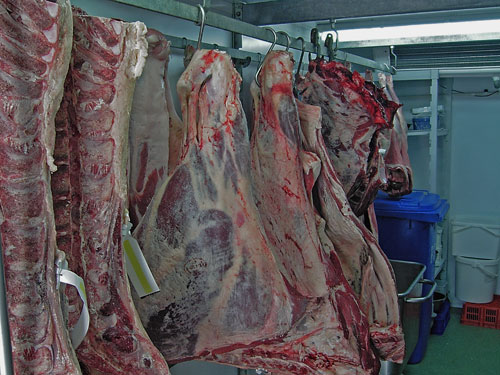What are quality marks?
They are the indicators present on a carcass that enable the quality of that carcass to be assessed.
In modern abattoirs (EEC Approved) carcase grading is done by verterinary officers working for the Meat Hygiene Service.
The officers assess a carcass against criteria that should be applied in all EEC Member States.
The grades are determined by visual inspection, the genaral shape and confirmation (muscle definition and meat to bone ratio) is the first criteria, the initials E.U.R.O.P. are used to establish the first grade, E being Excellent and P being Poor - The latter is often used in manufactured product that include ready meals.
A number is then applied to the grade - the number relates to the amount of fat present on the outer surface of the carcass, 4 being the optimum.
The letters L and H indicate Light and Heavy.
Broughs Butchers specify animals (cattle) that meet or exceed the designated grade of R 4L.
A similar grading system for lambs is used, pigs are also graded but accompanied with a probe number. Following slaughter, a probe (needle) is pressed into the back of the carcass at several places, the depth of fat is measured and the overall probe number is recorded as part of the grade assessment.
Sex, age and origin for each animal is recorded on an ear tag, to enable full traceability.
Years before the European grading system was introduced butchers had to use their eyes and experience to establish, age,sex, breed (general) and ratio's.

Traditional way of assessing quality
Many years ago in the summer holidays, my brothers and I accompanied my father Peter to Stanley Meat Market on Prescott Road in Liverpool, Monday and Wednesday each week.
We saw all that went on, thousands of carcases hanging on a fascinating overhead rail system, the fun, the banter, the bargaining and the deals. My father taught us about the quality marks that we should observe in determining a good carcass.
It was an absorbing business, in those days Stanley meat market was a bustling colourful place with people and characters to match.
A lot of meat was pitched, and so an appreciative eye for a good carcass was exercised on every visit.
I enjoyed every minute of the experience, eventually a quick inspection would tell me the age, sex, condition, and quality of the examined carcass, and in those days it was possible to identify breed with reasonable accuracy.
The quality marks that I learned as a boy have stood me in good stead, I fancy that I am still able to make an informed guess to establish a the finer characteristics of a carcass.
These days, we have fewer abattoirs and fewer wholesalers, the burgeoning rails of carcass that were Stanley have gone and European specifications have replaced the hands on selection techniques.
These days carcasses are graded on the slaughter line by a veterinary officer, the grading is pretty consistent and once a specification is established between the wholesaler and the butcher - a visual inspection is not required.
There will of course always be argument, perhaps between the farmer and the veterinary officer (the farmer is paid on grade) or the wholesaler and the butcher when the grade paid for is not the one received.
All in all, I am delighted that my career included visiting the market, the hands on physical examination, the banter and the haggle!

